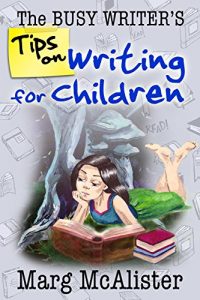Writing for children is one of the most enjoyable and rewarding things you can do. If you put your heart and soul into it, and focus on writing a good book that will appeal your target readership, you have a good chance of establishing a satisfying career.
But first... you need to have a good understanding of the basics: how to create a fast-paced plot that will hold the attention of your young readers, or how to write a picture book that will have small children spellbound with joy.
You need to know how to create vivid, memorable characters, and how to write dialogue that sounds real and moves your story along so that your readers can't wait to turn the page.
The Busy Writer's Tips on Writing for Children gives you an overview of the different categories of children's books, and shows you how to decide which one would be the 'best fit' for you.
The content includes:
* 10 Tips on Writing for Children
* An Overview of Children's Book Categories
* Writing Picture Books (including "10 Common Mistakes in Plotting Picture Books", and tips on how to think in pictures, fine-tuning your text and pictures, and writing in rhyme)
* Writing Stories for Children 6-12 (short books and chapter books for emergent readers; middle-range story books for 6-10 years and longer story books for 9-12 years)
* Writing for Young Adults (including 3 important tips on writing YA fiction and ideas about what to write for this market)
* Writing Non-Fiction for Children (including tips on finding non-fiction ideas and fine-tuning your ideas)
* Tips on Plotting (including the basics of a workable children's book and a handy plot outline)
* Tips on Creating Characters (how to make your characters seem real; how to create a story from a character; where to find good story characters; a look at stereotyped characters and tips on how to introduce your characters)
* Tips on Writing Dialogue (what you should include; how to set out dialogue; setting conversational goals; speech tags and action tags and a dialogue troubleshooter, with tips on fixing dialogue that doesn't sound right)
The book also tells you how to access to bonus plot and character sheets that you can download to your computer, print out and fill in to create your own special story.
"Tips on Writing for Children" is another winner in the 'Busy Writer' series!
But first... you need to have a good understanding of the basics: how to create a fast-paced plot that will hold the attention of your young readers, or how to write a picture book that will have small children spellbound with joy.
You need to know how to create vivid, memorable characters, and how to write dialogue that sounds real and moves your story along so that your readers can't wait to turn the page.
The Busy Writer's Tips on Writing for Children gives you an overview of the different categories of children's books, and shows you how to decide which one would be the 'best fit' for you.
The content includes:
* 10 Tips on Writing for Children
* An Overview of Children's Book Categories
* Writing Picture Books (including "10 Common Mistakes in Plotting Picture Books", and tips on how to think in pictures, fine-tuning your text and pictures, and writing in rhyme)
* Writing Stories for Children 6-12 (short books and chapter books for emergent readers; middle-range story books for 6-10 years and longer story books for 9-12 years)
* Writing for Young Adults (including 3 important tips on writing YA fiction and ideas about what to write for this market)
* Writing Non-Fiction for Children (including tips on finding non-fiction ideas and fine-tuning your ideas)
* Tips on Plotting (including the basics of a workable children's book and a handy plot outline)
* Tips on Creating Characters (how to make your characters seem real; how to create a story from a character; where to find good story characters; a look at stereotyped characters and tips on how to introduce your characters)
* Tips on Writing Dialogue (what you should include; how to set out dialogue; setting conversational goals; speech tags and action tags and a dialogue troubleshooter, with tips on fixing dialogue that doesn't sound right)
The book also tells you how to access to bonus plot and character sheets that you can download to your computer, print out and fill in to create your own special story.
"Tips on Writing for Children" is another winner in the 'Busy Writer' series!






